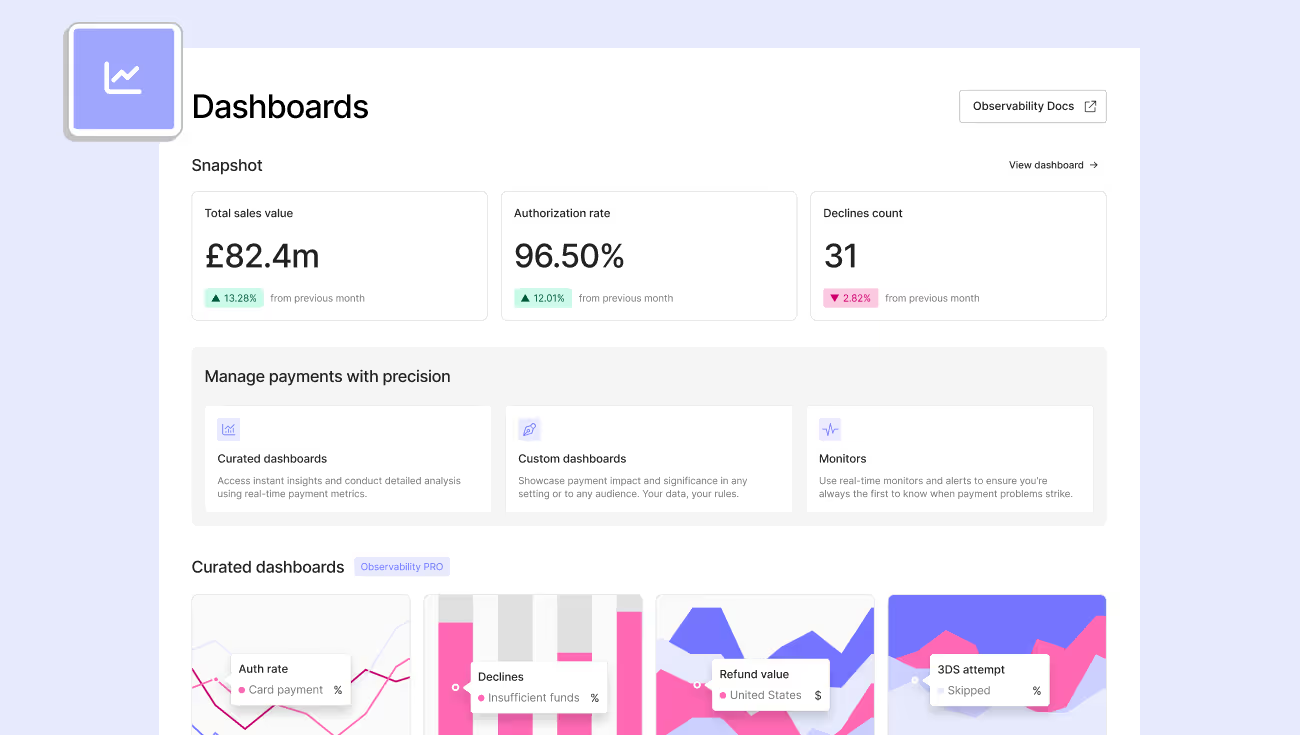The global subscription market is expected to reach $1.2 trillion by 2030.
With this growth, businesses are handling more merchant-initiated transactions (MITs), which are payments triggered by the merchant, using the customer’s payment details (usually provided during an earlier transaction).
In comparison with traditional customer checkout flows, MITs demand special attention to prevent involuntary churn, increase customer lifetime value, and maintain steady cash flow.
If you’re a merchant looking for payment retry strategies, you know MITs present unique challenges, such as:
- Higher decline rates compared to customer-initiated transactions (CITs)
- Limited insight into the decline reasons behind failed payments
- Managing complex retry logic and failed retry attempts
- Revenue loss due to involuntary churn
That’s why it’s essential to adopt a robust payment retry strategy that lets you recover failed transactions and minimize subscriber drop-off.
Keep reading to learn more.
Book a call with Primer to start optimizing your retry strategy now.
Why do MITs fail?
Understanding the most common reasons behind MIT failures is key to developing effective payment retry strategies. Here are some of the most common causes:
- Insufficient funds: The most prominent is payment failure due to insufficient funds. Our data finds that 56% of MIT failures are due to insufficient funds, compared to 18% when a customer initiates the transaction.
Customers typically use bank accounts or credit cards with sufficient funds when making online payments. In contrast, merchants initiating the transaction cannot know if the account has a positive balance or even if the card on file is still active.
- Reissued or expired cards: When a customer’s card expires, the issuing bank flags that card as inactive and will reject any transactions made with that card. Even if the customer’s card data is stored in the merchant’s system as a token, that token may be considered invalid, and the bank will decline it, sometimes with a generic “do not honor” code.
This is also a problem with reissued cards, even if the card numbers match. New expiration dates or differing credit card verification values (CCVs) can still result in declined transactions.
- Technical issues: Processor outages, site maintenance, and internet connectivity issues can also cause an MIT payment to decline. These types of payment declines can be difficult to diagnose. The merchant may not have insight into what caused the issue or when it will be resolved. That makes it difficult to know when to retry in order to avoid another failed payment attempt.
- Fraud detection flags and unnecessary SCA: Sometimes, a Merchant-Initiated Transaction (MIT) can experience a soft decline (meaning the transaction is recoverable) due to Strong Customer Authentication (SCA) requirements. SCA isn’t required for MIT payments, but sometimes a merchant incorrectly flags the transaction type when creating the payment. In this case, if the issuer or payment gateway perceives the transaction as a Customer-Initiated Transaction (CIT), they may trigger a 3D Secure (3DS) challenge to meet SCA requirements. Since the customer isn’t present to complete the challenge, the payment is declined.
Although unlikely, MIT payments can also be declined due to fraud risk. While MITs are generally considered low risk, since they are pre-agreed and the initial CIT would typically have passed SCA, issuers may still flag them if recent account activity suggests a higher risk profile. For example, stricter issuer risk models, recent chargebacks, or unusual customer behavior that suggests account takeover can all lead to payment failure.
In all of these cases, the biggest challenge with MITs is that customers are not actively engaged in the transaction. This means merchants often have to rely on a Dunning process to contact the customer and request payment. If follow-up is too aggressive or the customer experience is poor, this is likely to result in even higher churn rates.
.gif)
Read more: Why do payments fail, and what can merchants do?
Three actionable payment retry strategies
When merchants encounter hard declines due to a stolen card or suspected fraud, their options for resolution are limited.
However, they can retry some soft declines, such as the 56% of failed MIT payments attributable to insufficient funds.
Merchants' approaches to retrying these payments can vary widely. The key is to be mindful that card networks prefer to avoid a flood of repeated attempts in quick succession.
Try the following strategies:
1. Space out retry attempts over longer periods
Attempting to retry a payment multiple times on the days immediately following the decline can result in penalties from the payment processor.
A more sensible approach is to space out retry attempts, allowing for greater flexibility and a higher chance of successful payment recovery while minimizing the risk of incurring fines.
Some merchants reattempt the transaction once every day, over a period of up to 14 days, while others prefer to spread the number of retries they make over an even longer time frame.
For instance, one common strategy is to retry payments over the course of a month, doubling the days between each retry attempt. In this case, they would retry the payment on days 1, 2, 4, 8, 16, and 24.
The logic is that extending the retry period even further increases the likelihood that the consumer will have sufficient funds in their account by the time the next attempt is made.
2. Retrying on specific calendar dates
Geography can play a role in whether a retry attempt is successful. In many European countries, people receive their pay at the end of the month, so it is a good idea to plan an attempt on, say, the first day of the month to ensure they have just been paid.
In the US, many people receive their pay fortnightly, at the beginning and the middle of the month, so the optimal times to retry are around the 1st and the 15th.
3. Using data to optimize retry schedules
While there’s no guarantee of success with any strategy, it’s essential for each merchant to discover what works best for their specific situation. For example, one company found its ideal approach was to implement 11 retries over a two-week period.
They arrived at this conclusion by conducting a thorough profit-and-loss analysis, identifying when additional retries become counterproductive—when the costs of further attempts exceed the potential revenue recovery.
Many merchants are increasingly turning to AI and machine learning tools to optimize this process. AI software solutions can analyze patterns in historical data and predict which strategies will yield the best results for various customer segments across different regions. They serve as an extension of the trial-and-error process, continuously learning and adapting.
To find the best approach, you need to A/B test different retry strategies using intelligent payment routing. This approach enables merchants to test various retry attempt schedules (without disrupting payments) and then utilize data analytics to compare and refine their strategies.
Read more about A/B testing: The art and science of A/B testing in payments
Additional strategies for more successful transactions
As is the case in payments, prevention is always preferable to cure. While many merchants are concentrating on optimizing their retry strategies for MIT, there’s also a growing focus on exploring ways to prevent MIT failures from occurring in the first place.
Network tokenization
Traditionally, merchants have utilized tools like Account Updater to ensure they always work with a customer’s most up-to-date payment credentials.
Now, innovations like Network Tokens are taking this a step further. They ensure that a customer’s card-on-file payment details remain current and are also proven to increase authorization rates and reduce fraud.
Read more: How to optimize payments using network tokenization
Alternative payment methods
Merchants are increasingly exploring alternative payment methods (APMs) to enhance the success of their MITs. For example, some merchants are turning to Buy-Now-Pay-Later (BNPL) services, such as Klarna.
This approach eliminates the risks associated with card expiration or loss, as no physical card is involved in the transaction. Additionally, because payments are made in smaller installments, the likelihood of payment failure due to insufficient funds is minimized, unless the customer has reached their credit limit.
Open banking is another promising option that merchants are considering, as it enables account-to-account (A2A) payments. A2A payments prevent declines due to expired credentials, since funds are withdrawn directly from a user’s account. Furthermore, if a customer has an overdraft, payments can still be collected, again significantly reducing the chances of failure due to insufficient funds.
Read more: Alternative payment methods: offer customers more ways to pay
How Primer can help you optimize your payment retry strategies
Finding the right retry strategy requires experimentation, but a fragmented payment stack can hinder progress.
Implementing, testing, and optimizing each new strategy can involve managing engineering resources, consolidating and standardizing data from various reporting dashboards, and waiting weeks to add a new alternative payment method.
As a Unified Payment Infrastructure, Primer abstracts the complexity of payments into a single interface and API, connecting your entire global payment stack. This enables you to easily set up payment retries, test and optimize performance, and refine your strategy with minimal or no developer involvement.
Here are a few ways you can use Primer to optimize payment retry strategies:
Set up Fallbacks to automatically recover lost revenue
Fallbacks is Primer’s cascading payments solution. With just a few clicks and no code, you can start to recover previously lost revenue by routing any soft declined transaction to a backup payment processor (of your choosing). This is completely invisible to the customer, reducing friction.
Primer customer Banxa, a leading cryptocurrency platform, saw considerable success with Fallbacks. The platform processes $10 billion annually in over 150 countries, so it requires an ultra-strong strategy to combat payment failures and declines.
By implementing Primer Fallbacks to automate its payment retry strategy, Banxa recovered over US$7 million in revenue in the first half of 2024. The company is looking forward to adding more payment methods and fine-tuning its performance.
Read the full case study here: Banxa deploys Primer to break down barriers to crypto adoption
Customize payment Workflows
You can also set up customized payment routing using Primer’s drag-and-drop Workflows. Workflows enable you to experiment with more complex retry strategies, such as utilizing different backup processors for various transaction types.
With Workflows, you can set up dynamic retry logic based on factors like issuer response patterns, past retry success, common customer paydays, and more. You can also instantly A/B test and compare different payment flows, all without any coding.
Experiment using real-time data
To conduct successful experiments and continuously refine your retry logic, you need accurate data.
Primer’s Observability Dashboard brings together data from all your processors and payment methods, so you can test performance, analyze retry success rates, and A/B test new retry strategies.
With over 100 visualizations, 30+ filters, and a range of key metrics, Observability provides a unified view of all your payment data in real-time. You can also set up Monitors to receive notifications when payment failures spike or other anomalies occur, allowing you to respond and adapt your strategy faster.

You may also want to consider adding a new payment method, such as Buy Now, Pay Later (BNPL), to see how it affects your retry strategy. With Primer’s unified API, adding new payment methods takes just a few clicks, making it quick and simple to test their performance with Observability.
Network Tokenization through Primer’s vault
Finally, with Network Tokenization, Primer helps you avoid retries in the first place. Automatic token provisioning ensures that each customer’s payment information is securely stored and used for all subsequent MIT transactions. Primer automatically updates tokens with current customer payment details, so you don’t have to reach out to the customer or risk churn.
Tokens are stored in Primer’s Token Vault, which is processor-agnostic. This means your customer’s card details aren’t tied to any single payment processor. Instead, you can automatically use the same token to retry a payment with any alternative payment processor, enabling quicker retries and uninterrupted service.
Build a more effective retry strategy with Primer
There’s no one-size-fits-all solution to reducing payment attempts.
However, by understanding the root causes of MIT failures and implementing tailored data-driven retry strategies, merchants can significantly improve payment success rates, reduce involuntary churn, maximize revenue, and enhance customer retention.
Start by analyzing MIT failure data, experiment with different retry strategies, and explore advanced payment tools and alternative payment methods.
Book a call now to see how you can do it all with Primer.




(1).png)
.png)